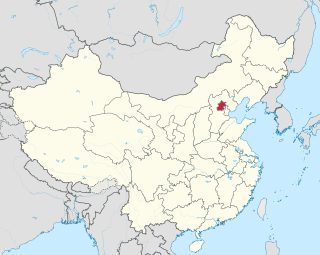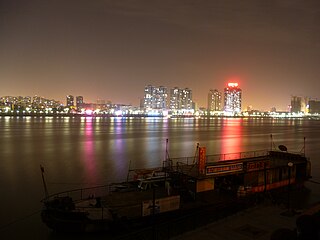
The Grand Canal, known to the Chinese as the Jing–Hang Grand Canal, a UNESCO World Heritage Site, is the longest canal or artificial river in the world. Starting in Beijing, it passes through Tianjin and the provinces of Hebei, Shandong, Jiangsu, and Zhejiang to the city of Hangzhou, linking the Yellow River and Yangtze River. The oldest parts of the canal date back to the 5th century BCE, but the various sections were first connected during the Sui dynasty. Dynasties in 1271–1633 significantly restored and rebuilt the canal and altered its route to supply their capital. The Grand Canal played a huge role in reunifying north and south China. The canal was built by conscripted laborers and connected the Yellow River in the north with the Yangtze River in the south, which made it much easier to transport grain from the south to the centers of political and military power in north China.

The Yellow River or Huang He is the second-longest river in China, after the Yangtze River, and the sixth-longest river system in the world at the estimated length of 5,464 km (3,395 mi). Originating in the Bayan Har Mountains in Qinghai province of Western China, it flows through nine provinces, and it empties into the Bohai Sea near the city of Dongying in Shandong province. The Yellow River basin has an east–west extent of about 1,900 kilometers (1,180 mi) and a north–south extent of about 1,100 km (680 mi). Its total drainage area is about 795,000 square kilometers (307,000 sq mi).

Hebei or, is a northern province of China. With a population of over 74 million people, Hebei is China's sixth most populous province. Its capital and largest city is Shijiazhuang. The province is 96% Han Chinese, 3% Manchu, 0.8% Hui and 0.3% Mongol. Three Mandarin dialects are spoken in Hebei: Jilu Mandarin, Beijing Mandarin and Jin.

Nanyang is a prefecture-level city in the southwest of Henan province, China. The city with the largest administrative area in Henan, Nanyang borders Xinyang to the southeast, Zhumadian to the east, Pingdingshan to the northeast, Luoyang to the north, Sanmenxia to the northwest, the province of Shaanxi to the west, and the province of Hubei to the south.

The Tarim River, known in Sanskrit as the Śītā, is an endorheic river in Xinjiang, China. It is the principal river of the Tarim Basin, a desert region of Central Asia between the Tian Shan and Kunlun Mountains. The river historically terminated at Lop Nur, but today reaches no further than Taitema Lake before drying out.

Pinggu District, formerly Pinggu County (平谷县), lies in the far east of Beijing Municipality. It has an area of 950 square kilometres (370 sq mi) and a population of 396,701. The district is subdivided into 2 subdistricts, 14 towns, and 2 townships. It borders the Beijing districts of Miyun and Shunyi to the north and west, respectively, Tianjin's Jizhou District to the southeast, and in Hebei province, Xinglong County and Sanhe to the northeast and south, respectively.

Beijing is a municipality located in North China at the northern tip of the North China Plain, near the meeting point of the Xishan and Yanshan mountain ranges. The city itself lies on flat land that opens to the east and south. The municipality's outlying districts and counties extend into the mountains that surround the city from the southwest to the northeast. The highest peaks are over 2,000 m (6,600 ft).

The Liao River is the principal river in southern Northeast China, and one of the seven main river systems in mainland China. Its name derived from the Liao region, a historical name for southern Manchuria, from which the Liaoning province, Liaodong Peninsula and Liao dynasty also all have derived their names. The river is also popularly known as the "mother river" in Northeast China. Coursing 1,345 kilometres (836 mi) long, the Liao River system drains a catchment basin of over 232,000 square kilometres (90,000 sq mi), but its mean discharge is quite small at only about 500 cubic metres per second (18,000 cu ft/s), about one-twentieth that of the Pearl River. The Liao River has an exceedingly high sediment load because many parts of it flow through powdery loess.

Chifeng, also known as Ulankhad, is a prefecture-level city in Southeastern Inner Mongolia, People's Republic of China. It borders Xilin Gol League to the north and west, Tongliao to the northeast, Chaoyang (Liaoning) to the southeast and Chengde (Hebei) to the south. The city has a total administrative area of 90,275 square kilometres (34,855 sq mi) and as of the 2020 census, had a population of 4,035,967 inhabitants. However, 1,175,391 of those residents lived in the built-up area made of the 2 urban districts of Hongshan and Songshan, as Yuanbaoshan is not conurbated yet. However, a large part of Songshan is still rural and Yuanbaoshan is a de facto separate town 27 kilometers away from the core district of Chifeng. The city was the administrative center of the defunct Ju Ud League.

Tongzhou District is a district of Beijing. It is located in southeast Beijing and considered the eastern gateway to the nation's capital. Downtown Tongzhou itself lies around 20 km (12 mi) east of central Beijing, at the northern end of the Grand Canal and at the easternmost end of Chang'an Avenue. The entire district covers an area of 906 km2 (350 sq mi), or 6% of Beijing's total area. It had a population of 673,952 at the 2000 Census, and has seen significant growth and development since then, growing to a population of 1,184,000 at the 2010 Census. The district is subdivided into four subdistricts, ten towns, and one ethnic township.

Xiangyang is a prefecture-level city in northwestern Hubei province, China and the second largest city in Hubei by population. It was known as Xiangfan from 1950 to 2010. The Han River runs through Xiangyang's centre and divides the city north–south. The city itself is an agglomeration of two once separate cities: Fancheng and Xiangyang, and was known as Xiangfan before 2010. What remains of old Xiangyang is located south of the Han River and contains one of the oldest still-intact city walls in China, while Fancheng is located to the north of the Han River. Both cities served prominent historical roles in both ancient and pre-modern Chinese history. Today, the city has been a target of government and private investment as the country seeks to urbanize and develop the interior provinces. Its built-up area made up of 3 urban districts had 2,319,640 inhabitants at the 2020 census while the whole municipality contained approximately 5,260,951 people.

The Dadu River, known in Tibetan as the Gyelmo Ngul Chu, is a major river located primarily in Sichuan province, southwestern China. The Dadu flows from the eastern Tibetan Plateau into the Sichuan Basin where it joins with the Min River, a tributary of the Yangtze River. Measured from its geographic source, the Dadu is actually longer than the Min and thus forms the main stem of the Min River system.

The Yongding River is a river in northern China. It is one of the main tributaries in the Hai River system and is best known as the largest river to flow through Beijing. In recent years, the Beijing segment of the river has dried up due to environmental issues. The Beijing Municipality government has invested 16 billion yuan in effort to replace the riverbed with parkland or smaller bodies of water.

Hejin is a county-level city of Yuncheng City, in the southwest of Shanxi province, People's Republic of China, located on the east (left) bank of the Yellow River. It borders Jishan and Wanrong counties to the east and south, Linfen to the north, and Hancheng in Shaanxi across the Yellow River to the west. As of 2002, it had a population of 360,000 residing in an area of 593 km2 (229 sq mi). The city and its surrounding area is home to abundant aluminium reserves. During the Qin Dynasty, Hejin was known as Pishi County, renamed to Longmen County during the Northern Wei, and finally Hejin County in the Song Dynasty. The city's name literally means "river ford", due to the need of a fording of the Yellow River at the time. In 1994, Hejin was upgraded to its present status as a county-level city.

The Han River is a river in southeast China. It is located mainly in eastern Guangdong province and has a total length of 410 kilometres (250 mi). The river is combined with two main tributary rivers, Mei River and Ting River, at Sanheba (三河坝), Dabu County. Han River flows south through the Han River Delta entering the South China Sea at Chenghai District and Longhu District of Shantou. The Teochew people refer to the river as "the Mother River".

The history of canals in China connecting its major rivers and centers of agriculture and population extends from the legendary exploits of Yu the Great in his attempts control the flooding of the Yellow River to the present infrastructure projects of the People's Republic of China. From the Spring and Autumn period onward, the canals of China were used for army transportation and supply, as well as colonization of new territories. From the Qin to the Qing, China's canal network was also essential to imperial taxation-in-kind. Control of shipbuilding and internal tariffs were also administered along the canals.

Liushahe is a town in Ningxiang, Hunan, China. It is surrounded by Qingshanqiao Town on the west, Huangcai Town and Shatian Township on the north, Laoliangcang Town and Huitang Town on the east, and Fanjiang Town on the south. As of the 2007 census it had a population of 68,780 and an area of 140.57 square kilometres (54.27 sq mi).
The 1679 Sanhe-Pinggu earthquake was a major quake that struck the Zhili region in Qing China on the morning of September 2, 1679. It is the largest recorded surface rupture event to have occurred in the North China Plain. The epicenter was located approximately 50 km (31 mi) east of the Imperial Palace in Beijing.
The Daling River is a river in Northeast China. With a length of 435 kilometres (270 mi), it is the main river in the arid western part of Liaoning. Its drainage basin covers 23,837 square kilometres (9,204 sq mi), 85% of which is located in Liaoning, 13% in Inner Mongolia and the remaining 2% in Hebei.

The Anning River is a river in the Hengduan Mountains region of southwestern Sichuan, China. The river is tributary of the Yalong River, itself a tributary of the Jinsha River which is the head stream of the Yangtze. The river is located primarily in Liangshan Prefecture except for the mouth of the river which enters the Yalong in Panzhihua Prefecture.

















